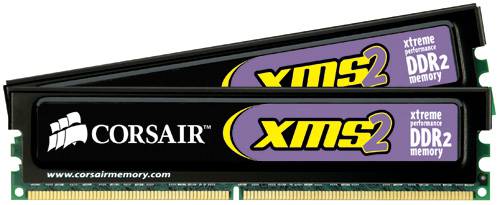- Qualcomm Launches Snapdragon 4 Gen 2 Mobile Platform
- AMD Launches Ryzen PRO 7000 Series Mobile & Desktop Platform
- Intel Launches Sleek Single-Slot Arc Pro A60 Workstation Graphics Card
- NVIDIA Announces Latest Ada Lovelace Additions: GeForce RTX 4060 Ti & RTX 4060
- Maxon Redshift With AMD Radeon GPU Rendering Support Now Available
Corsair EPP Technology Interview

NVIDIA unveiled a new technology designed for overclockers called EPP, or Enhanced Performance Profiles. NVIDIA chose Corsair to be their joint partner during production and in launch, so we sat down with John Beekley to ask some burning questions about the technology.
Page 1 – Introduction
This past Monday, NVIDIA announced a new feature of their nForce 5 chipset’s. The feature is called EPP, or Enhanced Performance Profiles and is primarily designed around making overclocking easier. You can read NVIDIA’s press release here and Corsairs coinciding release here.
New memory technologies happen often, but many don’t become mainstream very quickly. EPP is going to be different, because anybody will be able to take advantage of what it offers as soon as AM2 drops. EPP has been in the works for a while, and companies like Corsair have been directly beside NVIDIA’s side throughout the process to assure that things are done right. OCZ and a few other companies have been assisting NVIDIA also, but Corsair has will be the first to offer EPP modules to the public.
What is EPP? Well first let’s take a look at memory overclocking. When overclocking your CPU or memory, there are many factors that come into play to assure stable settings. On AMD specifically, you must worry about using memory dividers properly, along with CPU multipliers to make sure everything adds up to what you expect. It’s not as simple as plugging away simple options in your BIOS to give you a good overclock, but you will actually need to use your brain.
What CAS should I use? Should I tighten up my tRAS or leave it at 8? Should I begin to worry about secondary timings? More voltage? Argh! This can be very overwhelming for a new overclocker, and that’s where EPP comes in. In simple terms, EPP will take all of the options that enthusiast overclock’s use, and meld them into one option. With this one single option, you can overclock your CPU and memory at the same time.

Now the question comes into play.. What about the timings? Sure, overclocking your CPU and memory makes sense, but what about tightening or loosening of the timings to assure a stable overclock? EPP will essentially handle all the timings and other factors as well, which will make this a dream for those looking to get into the overclocking scene.
Since Corsair is the leading launch partner with NVIDIA on this technology, it was only fitting to interview them to get their input on what they think of it. They also clear up a lot of questions about the technology. John Beekley is the VP of App Engineering and co-founder at Corsair, and was happy to sit down and answer some burning questions.
Techgage: First off, thanks John for taking the time to answer our questions. EPP seems like quite an exciting new feature for DDR2 memory. What is it about EPP that makes memory better, and who exactly is best suited to take advantage of what EPP has to offer?
John Beekley: I wouldn’t say Enhanced Performance Profiles make memory "better", because to me that implies a performance improvement. But, I think that EPP provide real benefits for the memory user. The biggest benefit in my mind is that it takes data that used to be available only on printed datasheets and puts this information directly in the part. Once it is in the part, it can be used by the host motherboard’s BIOS to automatically configure the system. It can also be used by the more sophisticated enthusiast to gain insight about how the part is tested and how it should be expected to perform.
TG: Simply put, will we ever see EPP available on DDR1 modules?
JB: Simply put… almost certainly not.
TG: One thing that enthusiast overclocker’s enjoy is having the ability to tweak -all- available settings in the BIOS relating to their CPU and memory. While EPP consolidates all of these options into a single one, do you believe that any enthusiast overclocker’s will ever have a need for EPP?
JB: I don’t believe experienced overclocker’s will ever have a need for EPP… but I think they will certainly have a use for it. It is capable of providing a good "base camp" for ascending the difficult summit of an aggressive overclock. It also provides a guideline about how we were able to achieve aggressive performance.
TG: How closely did Corsair work with NVIDIA on the development of EPP? Were any other parties involved that helped the thought or technical process?
JB: Nvidia and Corsair were the primary parties developing this spec. We had many meetings back and forth, starting late last year, and they set up a lab for us within Nvidia so we could do platform testing in close proximity to the chipset and BIOS experts. Lots of smart people over there, and we are all focused on enthusiast products… it is a pleasure working with them, and they are an excellent partner.
TG: It recently became known that JEDEC is not interested in making EPP a standard feature for DDR2 modules. Do you think we will see JEDEC accept EPP in the future, and do you believe their refusal will hurt the technology?
JB: Well, let me clarify this a little. JEDEC did not state they are not interested in making EPP a JEDEC specification, they only made it clear that EPP has not been proposed to JEDEC, and is not a JEDEC specification. And, certainly, neither Nvidia or ourselves meant to imply that it was.
JEDEC is an industry-wide organization, and has to consider proposals like this very carefully and thoroughly, which is time consuming. A JEDEC specification takes at least two showings, a vote by the membership, and approval by the executive committee prior to publication. This process typically takes between nine and eighteen months. And, in general, much of the JEDEC membership (outside of Corsair and Nvidia, both of who are longtime members) is not geared towards overclocking, i.e. running components beyond their published specification.
Based on these constraints, we felt the best way to bring this spec to market was to create consensus between motherboard, chip set, processor, and memory suppliers, and then make a proposal to JEDEC. And we are actively engaged in doing this.
TG: EPP will allow a user to use a single option to overclock their CPU and memory at the same time. We understand that the EPP will automatically know how to handle the memory timings. Does EPP go beyond the standard tweaking of CAS-tRCD-tRP-tRAS and handle secondary timings, such as tRRD, tWR, tWTR among others?
JB: A full enhanced profile will handle clock speed, CAS latency, tRCD, tRP, tRAS, memory voltage, and command rate. In addition, it will handle drive strengths, fine delays, setup times, write recover time, and tRC. It is quite flexible!
TG: As it seems right now, EPP will only be available using the nF5 chipset on AMD AM2 systems. Will the nF5 for Intel, when it arrives, also support EPP?
JB: Well, I think that is a question for Nvidia! I would not be surprised to see it, though…
|
|
Support our efforts! With ad revenue at an all-time low for written websites, we're relying more than ever on reader support to help us continue putting so much effort into this type of content. You can support us by becoming a Patron, or by using our Amazon shopping affiliate links listed through our articles. Thanks for your support!





